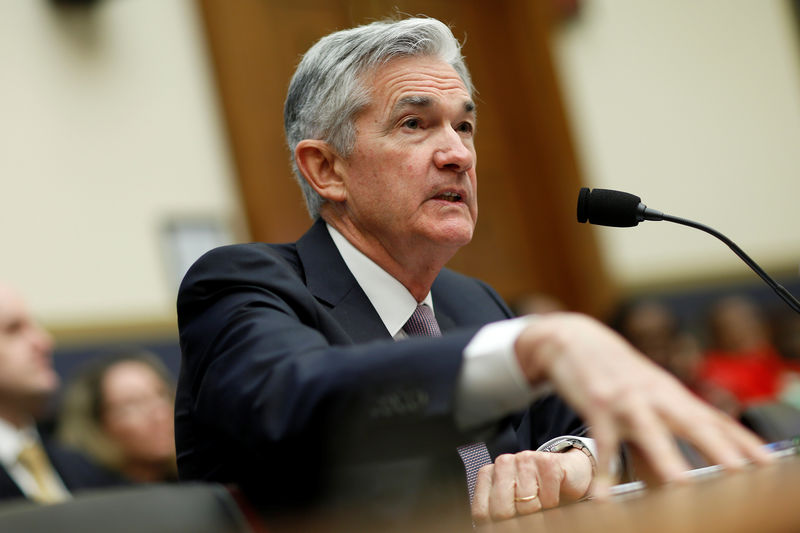By Yasin Ebrahim
Investing.com -- Federal Reserve chairman Jerome Powell is set to take center stage next week when he speaks at the Economic Club of New York on Thursday, where the focus will be on whether the Fed chief endorses recent remarks from fellow Fed members that an ongoing rise in Treasury yields could reduce the need for a final rate hike this year.
“In light of recent comments from other Fed officials, market participants will be watching closely to see if the leadership at the Fed share the same view that higher market rates if sustained will reduce the need for one final hike this year,” MUFG said in a note.
Since the Fed’s September meeting, the overarching narrative of ‘higher for longer’ rates has swept through markets, and put the bond market on course correction. A sharp selloff in Treasuries has pushed yields, particularly on the longer maturity 10-and 30-year bonds to 20-year highs.
The surge in yields, which San Francisco Fed president Mary Daly recently suggested is equivalent to about one rate hike, would suggest that the risk of lifting rates too high and tipping the economy into recession is growing.
How much will the threat of ‘two-sided’ risks influence Powell?
At the most recent FOMC press conference in September, Powell flagged the risk of overtightening – or lifting rates too far above “sufficiently restrictive” levels – as an emerging concern.
Against this growing two-sided risk, the “commonsense thing to do,” Powell said, is to “move a little more slowly” on rate hikes as you approach sufficiently restrictive. With many at the Fed still arguing that the impact of the 11-rate hikes seen so far are yet to fully filter through the economy, the need to move more slowly on tightening appears to be on the up and up.
A caution approach toward monetary policy has been echoed in recent weeks by several Federal Open Market Committee participants.
“There appears to have been a coordinated attempt by Fed officials to signal more concern over the sharp move higher in U.S. yields which has contributed to a significant tightening in US financial conditions that is equivalent to one or two 25bps rate hikes by the Fed,” MUFG added.
This apparent shift in tone from Fed members to a less hawkish bias was more evident following release of the FOMC September meeting minutes, when a “majority of participants judged that one more increase in the target federal funds rate at a future meeting would likely be appropriate.”
Markets appear to be betting that the Fed is done, with interest-rate futures pricing now implying a less than 30% chance of another rate hike this year.
The potential perils of endorsing a less hawkish stance
But endorsing the view of his Fed colleagues, isn’t without risk for Powell. It may cement bets that the Fed rate-hike cycle is over, muddying the Fed’s higher for longer narrative, potentially undoing some of recent tightening in financial conditions.
"If those higher long-term yields are higher because their expectations about what we're going to do has changed, then we might actually need to follow through in their expectations in order to maintain those yields,” Minneapolis Fed President Neel Kashkari said earlier this week.
Kashkari remarks serve as reminder about the Fed's prior reservations about "unwarranted" easing in financial conditions, especially if driven by misperception about its reaction function.
Powell may give nod to rising yields, but not much more
Powell may, however, also opt to pour cold water on the significance of the move higher in Treasury yields, Scotiabank (TSX:BNS) says, attributing it to a litany of “temporary forces” including the larger-than-expected issuance, or supply, of Treasuries with “bigger and more frequent auction sizes.”
The U.S. Treasury has issued a wave of U.S. government bonds amid plans to borrow a near-record $1.859 trillion of debt in the second half of 2023, to refill its coffers that were depleted - after running down reserves to fund government operations - following the debt ceiling debacle earlier this year.
While the potential risk of mid-November government shutdown could spark a fresh need for the Treasury to raise more cash, Powell could argue that the pace at which the Treasury is filling its confers will eventually slow, easing the supply pressures on U.S. government bonds that have pushed yields higher.
Lean into data dependence, maintain flexibility
Recent history would suggest that Powell isn’t likely to imply that the Fed could be done with rate hikes. Keeping the projection for a final quarter-point hike this year has not only allowed the Fed to maintain flexibility on policy, but also help manage market expectations, which had been, up until recently, fighting the Fed’s 'higher for longer' narrative at every turn.
Powell may lean into the recent mix of economic data to reiterate the need for the Fed to maintain the status quo data dependent policy.
Recent data showed that core CPI is on the move higher, again. The September payrolls report surprised to the upside. And economic growth, which Powell said in September was a factor behind FOMC members reducing their rate-cut forecasts to two from four next year, remains resilient.
“This is the fifth consecutive quarter in which GDP growth has been blowing the barn doors off of consensus expectations with the median tracking for Q3 at 3% q/q SAAR,” Scotiabank Economics said in a note.
With the Nov. 1 Fed meeting just weeks away, and pause on rate hikes largely baked into markets, Powell may likely opt for a balance in his remarks by acknowledging the recent rise in yields, but suggest more time is needed to assess whether they’re likely to persist, while reiterating the Fed’s data dependence stance.
This may appease the monetary policy hawks, the number of which continue to dwindle, and the doves, allowing the Fed to maintain the status quo, rather than shifting communication at a time when many agree that the last mile toward 2% inflation will be challenging.
